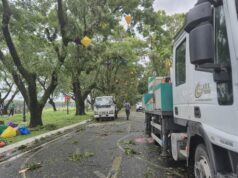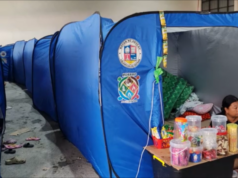At this time of great calamity that brings so much social hardships and economic difficulties all around, including in Central Luzon and, in particular, the Metro Clark area (that is, Angeles City, Mabalacat, Porac, Bamban and Capas), it is important to be reminded about why the Clark Development Corporation (CDC) was created. But first, a brief background on how CDC came into being.
CDC came into existence by virtue of Republic Act No. 7227, otherwise known as the Bases Conversion and Development Act of 1992, Section 15 of which provides:
“Sec. 15. Clark and Other Special Economic Zones. – Subject to the concurrence by resolution of the local government units directly affected, the president is hereby authorized to create by executive proclamation a Special Economic Zone covering the lands occupied by the Clark military reservations and its contiguous extensions as embraced, covered and defined by the 1947 Military Bases Agreement between the Philippines and the United States of America, as amended, located within the territorial jurisdiction of Angeles City, Municipalities of Mabalacat and Porac, Province of Pampanga, and the munici[pality of Capas, Province of Tarlac, in accordance with the provision as herein provided insofar as to the Clark military reservations.
“The governing body of the Clark Special Economic Zone shall likewise be established by executive proclamation” [NOTE: CDC was created by Executive Order No. 80. series of 1993, to serve as the governing body of the Clark Special Economic Zone, now the Clark Freeport and Special Economic Zone by virtue of RA 9400] “with such powers and functions exercised by the Export Processing Zone Authority pursuant to Presidential Decree No. 66, as amended.
“The policies to govern and regulate the Clark Special Economic Zone shall be determined upon consultation with the inhabitants of the local government units directly affected which shall be conducted within six (6) months upon approval of this Act.”
I was the mayor of Angeles City when RA 7227 was being drafted by Congress in 1992. Together with some friends in the affected local government units and in the civic and media groups (I remember in particular Bong Lacson, Sonny Lopez, the late Odi Fabian, and several others), we were consulted and took active part in helping draft the aforementioned provisions, and after the bill had been drafted, I spearheaded the effort to gather the required support of the LGUs and communities for the enactment of the bill into law (RA 7227) containing the aforecited provisions—as a provision therein requires that the support of the LGUs and communities directly affected was needed for the enactment of the bill into law.
As to why CDC was created, the reasons are clearly expressed in the WHEREAS portions of Executive Order No.80 authorizing its establishment, quoted below as follows:
“WHEREAS, the national leadership notes with deep concern the magnitude of the economic and social problems in Central Luzon, particularly in the city of Angeles, and the Municipalities of Mabalacat, Porac, Bamban and Capas, as a result of the Mt. Pinatubo eruptions and the withdrawal of the US Military Forces from Clark Air Base, and the need to address this immediate concern by way of providing employment and livelihood opportunities and resettlement and relocation sites;
“WHEREAS, it is the policy of the Government to accelerate the sound and balanced conversion of the Clark military reservations and its contiguous extensions into productive civilian uses to promote the economic and social development of Central Luzon in particular and the country in general;
“WHEREAS, the Bases Conversion and Development Authority (BCDA) is mandated by Republic Act No. 7227 (RA 7227), otherwise known as the “Bases Conversion and Development Act of 1992”, to adopt, prepare, and implement a comprejensive and detailed planfor the conversion of the Clark military reservations and its contiguous extensions consistent with the plans and programs of the national and local governments;
“WHEREAS, it is envisioned that Clark will be converted into an international civil aviation complex, a modern industrial estate, and tourism, trade and business center for Luzon and Asia;
“WHEREAS, the national leadership is cognizant of the vital roles of the private sector and the local government units in the bases conversion program.”
Immediately following the WHEREASes is “Section 1. Creation of the Clark Development Corporation. – A body corporate to be known as the Clark Development Corporation (CDC) is hereby authorized to be formed as the operating and implementing arm of the BCDA to manage the Clark Special Economic Zone (CSEZ)”—-thus showing the rationale for the creation of the CDC.
The urgent primary reason for the creation of CDC then, clearly, is “to provide employment and livelihood opportunities and resettlement and relocation sites” for the victims of the calamity by way of addressing their serious economic and social problems and of alleviating their condition and giving them immediate relief.
To implement the specific mandate of CDC, former CDC presidents Antonio Henson (1993-1995) and Romeo S. David (1995-1998) during their respective tenures provided employment and livelihood opportunities for the Aetas, former base workers, and the residents of the directly affected LGUs, to wit: Angeles City, Mabalacat, Bamban and Porac either by hiring them directly or giving them top priority to implement livelihood projects that the CDC developed precisely for the purpose of giving them opportunities to improve their social and economic condition.
This laudable undertaking, however, was discontinued in October 1998 by the successor of former CDC president David and has not been revived since then. I am happy to note, though, that the present CDC president and chief executive officer, my good friend Benigno “Benny” N. Ricafort, appears to have taken initial steps to resume implementation of CDC’s primary mandate. His recent moves toward alleviating the social and economic needs of the Aetas are in that direction.
If Benny can follow through such initiative with the creation of livelihood projects and such other job-generating programs similar to those implemented during Henson’s and David’s time—which saw employment in the Clark Special Economic Zone rising from virtual zero to 56,000 jobs [25,000 actual jobs and 31,000 transient jobs] by the third quarter of 1998—-the present social and economic hardships brought about by the calamitous events that struck the Metro Clark Area will be greatly alleviated.
And CDC will have then fully lived up to its original mandate. How about it, Benny? Agyu tamu ine, abe.
Mabuhay and see you again next week.
CDC came into existence by virtue of Republic Act No. 7227, otherwise known as the Bases Conversion and Development Act of 1992, Section 15 of which provides:
“Sec. 15. Clark and Other Special Economic Zones. – Subject to the concurrence by resolution of the local government units directly affected, the president is hereby authorized to create by executive proclamation a Special Economic Zone covering the lands occupied by the Clark military reservations and its contiguous extensions as embraced, covered and defined by the 1947 Military Bases Agreement between the Philippines and the United States of America, as amended, located within the territorial jurisdiction of Angeles City, Municipalities of Mabalacat and Porac, Province of Pampanga, and the munici[pality of Capas, Province of Tarlac, in accordance with the provision as herein provided insofar as to the Clark military reservations.
“The governing body of the Clark Special Economic Zone shall likewise be established by executive proclamation” [NOTE: CDC was created by Executive Order No. 80. series of 1993, to serve as the governing body of the Clark Special Economic Zone, now the Clark Freeport and Special Economic Zone by virtue of RA 9400] “with such powers and functions exercised by the Export Processing Zone Authority pursuant to Presidential Decree No. 66, as amended.
“The policies to govern and regulate the Clark Special Economic Zone shall be determined upon consultation with the inhabitants of the local government units directly affected which shall be conducted within six (6) months upon approval of this Act.”
I was the mayor of Angeles City when RA 7227 was being drafted by Congress in 1992. Together with some friends in the affected local government units and in the civic and media groups (I remember in particular Bong Lacson, Sonny Lopez, the late Odi Fabian, and several others), we were consulted and took active part in helping draft the aforementioned provisions, and after the bill had been drafted, I spearheaded the effort to gather the required support of the LGUs and communities for the enactment of the bill into law (RA 7227) containing the aforecited provisions—as a provision therein requires that the support of the LGUs and communities directly affected was needed for the enactment of the bill into law.
As to why CDC was created, the reasons are clearly expressed in the WHEREAS portions of Executive Order No.80 authorizing its establishment, quoted below as follows:
“WHEREAS, the national leadership notes with deep concern the magnitude of the economic and social problems in Central Luzon, particularly in the city of Angeles, and the Municipalities of Mabalacat, Porac, Bamban and Capas, as a result of the Mt. Pinatubo eruptions and the withdrawal of the US Military Forces from Clark Air Base, and the need to address this immediate concern by way of providing employment and livelihood opportunities and resettlement and relocation sites;
“WHEREAS, it is the policy of the Government to accelerate the sound and balanced conversion of the Clark military reservations and its contiguous extensions into productive civilian uses to promote the economic and social development of Central Luzon in particular and the country in general;
“WHEREAS, the Bases Conversion and Development Authority (BCDA) is mandated by Republic Act No. 7227 (RA 7227), otherwise known as the “Bases Conversion and Development Act of 1992”, to adopt, prepare, and implement a comprejensive and detailed planfor the conversion of the Clark military reservations and its contiguous extensions consistent with the plans and programs of the national and local governments;
“WHEREAS, it is envisioned that Clark will be converted into an international civil aviation complex, a modern industrial estate, and tourism, trade and business center for Luzon and Asia;
“WHEREAS, the national leadership is cognizant of the vital roles of the private sector and the local government units in the bases conversion program.”
Immediately following the WHEREASes is “Section 1. Creation of the Clark Development Corporation. – A body corporate to be known as the Clark Development Corporation (CDC) is hereby authorized to be formed as the operating and implementing arm of the BCDA to manage the Clark Special Economic Zone (CSEZ)”—-thus showing the rationale for the creation of the CDC.
The urgent primary reason for the creation of CDC then, clearly, is “to provide employment and livelihood opportunities and resettlement and relocation sites” for the victims of the calamity by way of addressing their serious economic and social problems and of alleviating their condition and giving them immediate relief.
To implement the specific mandate of CDC, former CDC presidents Antonio Henson (1993-1995) and Romeo S. David (1995-1998) during their respective tenures provided employment and livelihood opportunities for the Aetas, former base workers, and the residents of the directly affected LGUs, to wit: Angeles City, Mabalacat, Bamban and Porac either by hiring them directly or giving them top priority to implement livelihood projects that the CDC developed precisely for the purpose of giving them opportunities to improve their social and economic condition.
This laudable undertaking, however, was discontinued in October 1998 by the successor of former CDC president David and has not been revived since then. I am happy to note, though, that the present CDC president and chief executive officer, my good friend Benigno “Benny” N. Ricafort, appears to have taken initial steps to resume implementation of CDC’s primary mandate. His recent moves toward alleviating the social and economic needs of the Aetas are in that direction.
If Benny can follow through such initiative with the creation of livelihood projects and such other job-generating programs similar to those implemented during Henson’s and David’s time—which saw employment in the Clark Special Economic Zone rising from virtual zero to 56,000 jobs [25,000 actual jobs and 31,000 transient jobs] by the third quarter of 1998—-the present social and economic hardships brought about by the calamitous events that struck the Metro Clark Area will be greatly alleviated.
And CDC will have then fully lived up to its original mandate. How about it, Benny? Agyu tamu ine, abe.
Mabuhay and see you again next week.




